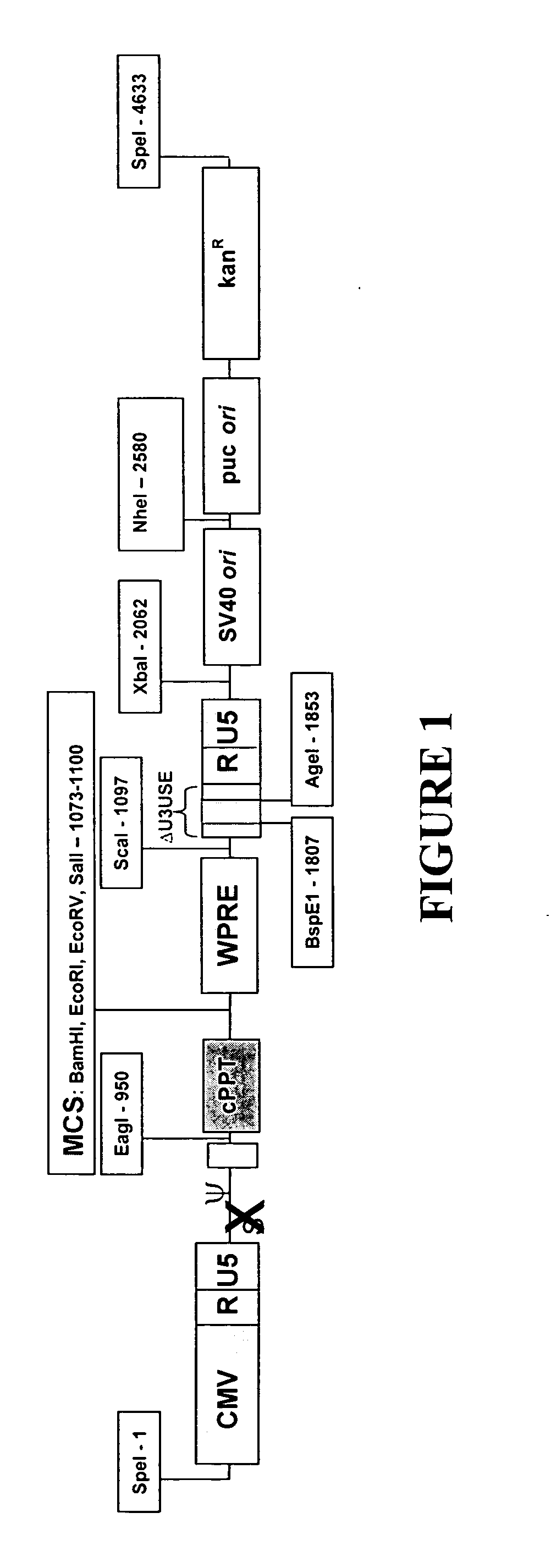Minimal lentiviral vector system
- Summary
- Abstract
- Description
- Claims
- Application Information
AI Technical Summary
Benefits of technology
Problems solved by technology
Method used
Image
Examples
example 1
Lentiviral Transfer Vector pIC: General Features
[0111]FIG. 1 shows the main features and cloning sites of the lentiviral transfer vector pIC (not drawn to scale). Since the NheI, SpeI and XbaI restrcition sites have complimentary overhangs, any of the backbone elements (SV40 ori, kanamycin resistance and puc ori) can be easily taken out and swapped or removed. In addition there is a Multiple Cloning Site (MCS) that contains unique sites, include a blunt cutter (EcoRV), for ease of insertion of heterologous sequences. The WPRE is included as a feature that enhances vector titer and gene expression, and is flanked by ScaI and EcoRV sites. The SV40 poly(A) enhancer element (box between BspE1-1807 and Agel-1853) is flanked by BspEI and AgeI sites that have complimentary overhangs. Extra elements can be inserted into 3′ U3 at the unique BspE1 site.
example 2
Lentiviral Transfer Vector pIC: Fragments to Assemble
[0112] The lentiviral transfer vector pIC was assembled by assembling various fragments, designated fragments 1-7 in FIGS. 2-8 herein (SEQ ID NO: 1; SEQ ID NO: 2; SEQ ID NO: 3; SEQ ID NO: 4; SEQ ID NO: 5; SEQ ID NO: 6; SEQ ID NO: 7), using the primers shown below. In FIGS. 2-8, the sequences in normal font or italic font are the actual sequence present in the final plasmid construct. The sequences in underlined font overlap 4 bp stretches at the end of each fragment and are used to facilitate ligation of the fragments, but are not duplicated in the final products. Fragments were assembled using gene self-assembly (GENSA) technology (Solaiman F, et al., Modular retro-vectors for transgenic and therapeutic use. Mol Reprod Dev. 2000 June; 56(2 Suppl):309-315).
[0113] The fragments were assembled by polymerase chain reaction (PCR) in accordance with known techniques. The primers used for assembly of the fragments were as follows:
(S...
example 3
Construction of Packaging Construct, pGPRcwVA
[0115] (1) pGPR: expresses HIV-1 Gag-Pol from a CMV immediate early promoter, but does not contain any other HIV-1 genes (ie Env, Tat, Rev and the accessory genes Vpu, Vif, Vpr and Nef). It was derived from plasmid pHIV-DY, where the LTRs have been replaced by a CMV promoter / β-globin intron at the 5′ end, and a β-globin poly(A) sequence at the 3′ end, part of the env gene is deleted, and all the accessory proteins are retained (reference Sutton et al. 1998). We cut pHIV-DY with restriction sites PflM1 and Not I, and replaced this fragment with a PCR generated fragment corresponding to the HIV-1 Rev-response-element (RRE). The RRE fragment was generated by PCR using HIV-DY as a template. The sequence amplified was from 5592 to 5828 (numbering according to HIV-DY sequence). Restriction sites PflM1 and NotI were tagged to the 5′ and 3′ primers respectively. The RRE PCR fragment was cut with PflM1 and NotI restriction enzymes and cloned into...
PUM
| Property | Measurement | Unit |
|---|---|---|
| Nucleic acid sequence | aaaaa | aaaaa |
| Selectivity | aaaaa | aaaaa |
Abstract
Description
Claims
Application Information
 Login to View More
Login to View More - R&D
- Intellectual Property
- Life Sciences
- Materials
- Tech Scout
- Unparalleled Data Quality
- Higher Quality Content
- 60% Fewer Hallucinations
Browse by: Latest US Patents, China's latest patents, Technical Efficacy Thesaurus, Application Domain, Technology Topic, Popular Technical Reports.
© 2025 PatSnap. All rights reserved.Legal|Privacy policy|Modern Slavery Act Transparency Statement|Sitemap|About US| Contact US: help@patsnap.com



